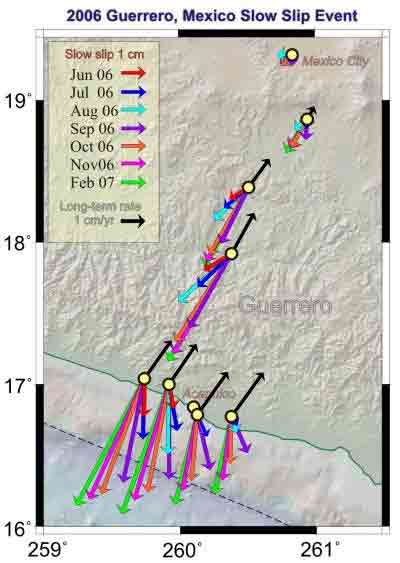In Surprise, Major Earthquake Fault Slips Backward

A vast chunk of Earth sliding under Mexico has surprisingly reversed direction, puzzling geologists and leaving them wondering whether the ground might be poised to pummel Mexico City with a devastating earthquake.
The offshore tectonic plate had been sliding toward Mexico City at a rate of 1 inch per year, as recorded by Global Positioning System measuring stations near Acapulco and Guerrero, which is about 175 miles southwest of Mexico City.
That movement was normal, as predicted by theories of how Earth's crustal plates should move. At subduction zones, like this one, an oceanic plate typically slides beneath a continental plate, and now and then major temblors occur.
Suddenly, in the latter half of 2006, the plate began moving the other way and quadrupled its speed, scientists announced today.
History of big quakes
Coastal Mexico, like much of the Pacific Rim, is prone to big quakes, and geologists know another major one will eventually strike. They can't say when or where.
In 1985, a magnitude-8.1 event centered north of Guerrero killed 10,000 people in Mexico City.
Sign up for the Live Science daily newsletter now
Get the world’s most fascinating discoveries delivered straight to your inbox.
The last major quake centered in Guerrero, however, was a magnitude-7.6 event in 1911. Scientists think strain on this local fault has been building and the area may be ripe for a much larger quake, perhaps in the magnitude range of 8.1 to 8.4, Larson said.
"A very large earthquake in Guerrero would produce seismic waves that would travel quickly to the Mexican capital, and since Mexico City is built on water-saturated lakebed deposits that amplify seismic energy, the results would be catastrophic," said University of Colorado at Boulder engineering professor Kristine Larson.
In a major earthquake, saturated soil can essentially liquefy, which residents near San Francisco Bay learned in the catastrophic 1989 Loma Prieta quake. Buildings simply lose their footing and tumble.
Important discovery
Meantime, the reversal of the fault is itself an important discovery. Similar reversals have been noted at other subduction zones, such as the highly active Cascadia region off the coast of Washington and Oregon. But this is the largest such backward event so far detected.
"Before GPS, we thought the ground moved at a constant speed between earthquakes," Larson said. "The recognition of these transient events where the plate reverses direction is arguably the most important geophysical discovery that has stemmed from the introduction of GPS measurements."
Earthquakes remain frustratingly difficult to predict, nonetheless. Not enough is known about these reversals to say how they might or might not presage any shaking.
"The million-dollar question is whether the event makes a major earthquake in the region less likely or more likely," Larson said. "So far, it does not appear to be reducing the earthquake hazard."
The research, detailed in the Aug. 1 issue of the journal Geophysical Research Letters, is funded in part by the National Science Foundation and supported by the National Autonomous University of Mexico.
- The Big Earthquake Quiz
- Video: Earthquake Forecasts
- Natural Disasters: Top 10 U.S. Threats
Robert is an independent health and science journalist and writer based in Phoenix, Arizona. He is a former editor-in-chief of Live Science with over 20 years of experience as a reporter and editor. He has worked on websites such as Space.com and Tom's Guide, and is a contributor on Medium, covering how we age and how to optimize the mind and body through time. He has a journalism degree from Humboldt State University in California.











